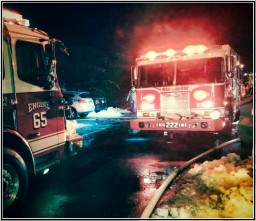 Smart Meter Fires: … How much risk is finally too much when the results of failure can be catastrophic?
Smart Meter Fires: … How much risk is finally too much when the results of failure can be catastrophic?
The Saskatchewan Smart Meter Fiasco
The recent events in Saskatchewan, Canada have refocused attention on one of the many risks associated with “smart” utility meters, i.e., the increased risk of fires.
As previously reported on July 30, the Saskatchewan government has ordered SaskPower to remove all 105,000 smart meters that have been installed across the province following several fires linked to the devices.
On Friday, August 1, the news coverage continued in Saskatchewan regarding the smart meter fires. An article in the Leader-Post made reference to a “Smart Meter Fiasco” and gave credit to the provincial government for:
“insisting that eight meters out of 105,000 catching fire (a 99.992-per-cent success rate, according to SaskPower) was simply unacceptable. Setting aside the moral issue of endangering human lives, the liability costs of house fires could be massive. It would have been far more cynical to have just kept installing smart meters in the hope that nothing would happen.”
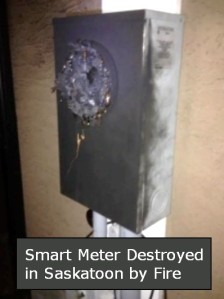 At the same time, however, mention was made of tough questions being asked by the opposition political party, such as:
At the same time, however, mention was made of tough questions being asked by the opposition political party, such as:
“Why did the government not use qualified electrical workers for these installations and will the government cancel its exemption and ensure that only qualified electrical workers are involved in uninstalling these blame meters?”
“What are the details of the government’s purchase agreement with Sensus Inc., the American supplier of these meters?”
“Why does it need to take six to nine months to uninstall these dangerous meters?”
It is noted that the above link for “article” is no longer available from the original source; here is an archive link: http://web.archive.org/web/20140805063224/http://www.leaderpost.com/technology/Mandryk+Smart+meter+fiasco+Wall+problem/10081733/story.html
… and in a separate article:
“[W]hy didn’t [the government] act sooner when problems with the smart meter program came to light. SaskPower representatives have said the Crown corporation continued pursuing a partnership with Sensus even after it found out about incidents in the United States where its meters had been tied to malfunctions and recalls.”
It is noted that the above link for “article” is no longer available from the original source; here is an archive link:
http://web.archive.org/web/20140807202900/http://www.leaderpost.com/technology/calls+independent+smart+meter+review/10083886/story.html
Smart Meter Fires Outside Saskatchewan
Smart meter fires have occurred around the world, but some of the most recently reported problems have occurred with meters manufactured by Sensus:
- Portland General Electric in Oregon is recalling 70,000 residential Sensus smart meters that run the risk of catching fire. PGE’s internal analysis and tests — confirmed by independent experts hired by the company — show this meter type did not perform optimally and in an extremely rare case, a meter could catch fire. Three small meter fires involving this type of meter have been reported in PGE’s service territory, with minor property damage in one case.
It is noted that the above hyperlink for the Sensus recall of smart meters is no longer available from the original source; here is an archive link: http://web.archive.org/web/20151024041909/https://www.portlandgeneral.com/our_company/news_issues/news_releases/07_23_2014_exchanging_subset_meters.aspx
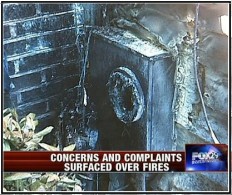 PECO Energy in Philadelphia, PA also replaced all its Sensus smart meters in 2012 after several of them overheated and caught fire, two of them resulting in serious house fires, according to the Philadelphia Inquirer. PECO hired Underwriters Laboratories (UL) and two independent consultants to examine the meters. Their reports convinced the utility to swap out all the meters manufactured by Sensus Metering Systems Inc. of Raleigh, N.C., with those made by a Swiss vendor, Landis & Gyr AG.
PECO Energy in Philadelphia, PA also replaced all its Sensus smart meters in 2012 after several of them overheated and caught fire, two of them resulting in serious house fires, according to the Philadelphia Inquirer. PECO hired Underwriters Laboratories (UL) and two independent consultants to examine the meters. Their reports convinced the utility to swap out all the meters manufactured by Sensus Metering Systems Inc. of Raleigh, N.C., with those made by a Swiss vendor, Landis & Gyr AG.
It is noted that a hyperlink in the above paragraph is no longer available from the original source; here is an archive link: https://web.archive.org/web/20150421123141/http://articles.philly.com/2012-10-10/business/34343946_1_sensus-meters-sensus-devices-new-generation-meters
Here is an appropriate video for viewing regarding the PECO fires in 2012.
[The above video contains material used pursuant to Fair Use Doctrine under 17 U.S.C. 107 and is presented in the public’s interest for non-commercial purposes.]
However, in the case of PECO, just changing out the meter to another vendor did not solve the overall problem. [Note that in an interview in 2012 with Greentech Media, PECO’s Communications Manager said only that the Landis+Gyr meters “performed better in the field,” based on an independent investigation but would not elaborate on what that meant.]
It is noted that the above hyperlink for the Greentech Media article is no longer available from the original source; here is an archive link: http://web.archive.org/web/20150411070713/http://www.fierceenergy.com/story/inside-pecos-smart-meter-debacle/2012-10-15
In February 2014, a Landis smart meter caught fire and apparently exploded in Bensalem, Pennsylvania. The subsequent fire resulted in significant damage to an apartment building. This fire represents one of the most well-documented instances of a smart meter fire on record in terms of the damage, havoc, injury, and potential loss of life that can be caused by smart meters.
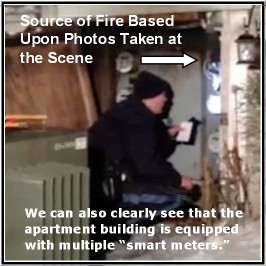 In the figure shown to the right, an officer as part of an investigation is shining a flashlight toward the two upper smart meters located on the right side of the outdoor shed. The upper most smart meter looks completely deformed (despite the somewhat poor resolution of this photo). There appears to be melted plastic drooping down from what would be the normal meter location. There is also blackened area at the top, where smoke, sparks, and fire previously billowed outward and upward.
In the figure shown to the right, an officer as part of an investigation is shining a flashlight toward the two upper smart meters located on the right side of the outdoor shed. The upper most smart meter looks completely deformed (despite the somewhat poor resolution of this photo). There appears to be melted plastic drooping down from what would be the normal meter location. There is also blackened area at the top, where smoke, sparks, and fire previously billowed outward and upward.
Dramatic camera footage exists taken soon after the fire started in Bensalem, during the fire fighting activities, and during the recovery efforts, making you feel as if you are “on-the-scene” as it happens. If you have any doubts on the potential damage and injury that can be caused by a smart meter, watch the following three (3) videos.
In the first video where you see the dramatic flames about 25 to 30 seconds into the video, they are emanating from an outdoor shed containing smart meters.
.
[The above video contains material used pursuant to Fair Use Doctrine under 17 U.S.C. 107 and is presented in the public’s interest for non-commercial purposes.]
Based upon all reports to date, the smart meter itself was the cause of the Bensalem apartment building fire, not arcing and not the wires. [Note: An original source of reporting for the smart meter fire included the following link: “Electric Meter Blamed for Bensalem Apartment Fire.” As a part of the report, it was indicated that Battalion Fire Chief Robert Sponheimer attributed the apartment building fire to a “meter malfunction.”]
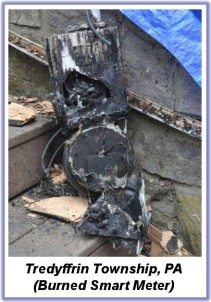 A review of records indicates another PECO installed Landis smart meter caught fire on February 27, 2013, shortly after installation. At a public meeting on March 18, 2013, Assistant Chief Eamon Brazunas, Berwyn Fire Company, recounted a “significant incident” where one fire call was “caused by sparking and arcing around the Smart-Meter installed by PECO. He encouraged homeowners to have an electrician inspect the interior once a Smart-Meter is installed on the exterior.” … Is everyone having this inspection performed to help avoid a catastrophic outcome due to smart meter installations? And why should anyone have to pay for this inspection?
A review of records indicates another PECO installed Landis smart meter caught fire on February 27, 2013, shortly after installation. At a public meeting on March 18, 2013, Assistant Chief Eamon Brazunas, Berwyn Fire Company, recounted a “significant incident” where one fire call was “caused by sparking and arcing around the Smart-Meter installed by PECO. He encouraged homeowners to have an electrician inspect the interior once a Smart-Meter is installed on the exterior.” … Is everyone having this inspection performed to help avoid a catastrophic outcome due to smart meter installations? And why should anyone have to pay for this inspection?
From an overseas perspective, an Australian news station aired an excellent review on smart meter fires in 2012; refer to the video shown below.
Concerns Over Smart Meter Fires Hit Ontario
TORONTO – As reported on Thursday, August 7, nearly half of Ontario’s 77 electricity distributors have installed so-called “smart” meters manufactured by a U.S. company whose equipment has been linked to nine fires in Saskatchewan, according to Ontario’s electricity regulator.
Smart meters have been linked to 23 incidents reported to Ontario’s Fire Marshal from 2011 to 2013.
“I can tell you 10 of those were smart meter failures attributed to internal faults, and 13 were small fires attributed to high-resistance heating,” said spokeswoman Carol Gravelle.
A New Democrat MPP [Member of Provincial Parliament] says the Liberal government is playing with people’s lives by not acting sooner on potentially hazardous smart meters that may have caused several Saskatchewan fires.
“I think it is imperative that the minister act quickly to find out whether or not we have these meters and have them removed immediately before somebody does gets hurt or before somebody’s home burns down,” NDP MPP Lisa Gretzky told reporters Thursday referring to Energy Minister Bob Chiarelli.
What Causes the Smart Meter Fires?
On August 1, Sensus issued a press release indicating that “Results of Smart Meter Investigation Point to External Factors.” This press release attempts to deflect responsibility away from the company (as part of a product defense strategy). Regarding recent “incidents,” the press release mentions that:
“one [incident] was caused by an issue with a meter base attached to a home, three were caused by utility over voltage, two were caused by water intrusion through the meter base and one remains under investigation.”
What do the explanations in the above mentioned press release really mean, a press release by the way, that never actually mentions the word “fire”?
Assuming we don’t reject the entire press release as nothing more than propaganda, let’s look at the “over voltage” issue. Is this a condition exacerbated by the fact a smart meter contains an electronic circuit board that would not have been an “issue” with an analog meter? On the so-called “water intrusion” issue, shouldn’t utility usage meters installed outdoors and subject to rain, sleet, snow, and condensation be designed to withstand at least some “water intrusion”? How much water intrusion was involved? Obviously water and electricity don’t mix, but was it just condensation that may have affected the electronics of a smart meter but not affected an analog meter? Have “water intrusion issues” been reported for analog meters? Rather than leakage through the meter base, is the problem possibly related to leakage of water into the meter itself which then interacts with the electronics?
With regard to the “meter base attached to a home issue,” are solid state meters in general more susceptible to overheating due to loose meter base jaws (and less durable construction)?
These are the types of probing questions that need to be asked and answered by independent and unbiased experts for these fire incidents and others reported world-wide. Why did Sensus issue a press release pointing to “external factors” with one meter still under investigation? Is this the one meter that Sensus can’t rationalize an “external factor” as the cause?
When smart meter fires have occurred in the past, utilities have many times blamed the “customer’s wiring” (or meter boxes, etc.) for the problem. However, after a review of news reports and technical blogs addressing smart meter-related fires, the most credible conclusions for the source of fires are as follows:
It is noted that the above hyperlink for “technical blogs” is no longer available from the original source; here is an archive link: http://web.archive.org/web/20121127115138/http://smartgridsherpa.com/blog/how-can-the-risks-of-smart-meter-malfunctions-be-more-fully-addressed-part-1
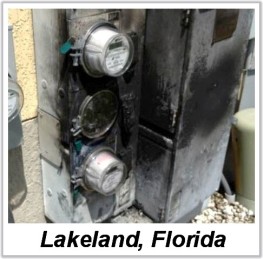 Insufficient care is taken by smart meter installers. Socket receptacles may be corroded when the switch from the analog meter is made to the smart meter. Rather than doing a quick swap, much more care needs to be taken with an associated inspection and cleaning of the meter socket by qualified personnel. For these types of situations, a fire might occur just because the meter is changed out in an improper manner (no matter what type of meter is involved with the swap), but the smart meter might still introduce inherent vulnerabilities due to the nature of its construction. Also, just for the record:
Insufficient care is taken by smart meter installers. Socket receptacles may be corroded when the switch from the analog meter is made to the smart meter. Rather than doing a quick swap, much more care needs to be taken with an associated inspection and cleaning of the meter socket by qualified personnel. For these types of situations, a fire might occur just because the meter is changed out in an improper manner (no matter what type of meter is involved with the swap), but the smart meter might still introduce inherent vulnerabilities due to the nature of its construction. Also, just for the record:
“the National Electrical Manufacturers Association (NEMA) “strongly recommends that all existing meter sockets be thoroughly inspected when electrical meters are installed. Inspection criteria should include (but not be limited to) indications of excessive heating, corrosion, loose connections or components, deformed socket jaws, broken components, failed insulation, damage due to ground settling or vandalism, or any exposed live parts.”
- Some manufacturers are just making “cheap” smart meters or have poor quality controls such that a fire becomes more likely. In these cases, the risk for a fire may be more dependent on the manufacturer of the meters themselves.
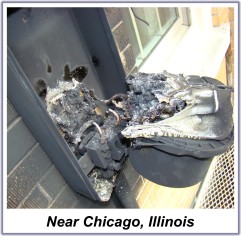 There is a material composition difference in the construction of the smart meters such that they may operate at higher temperatures or have a lower flash point. Plus, you have the more obvious difference that the smart meter contains at least one electronic circuit board and an analog meter does not. In addition to the so-called “hot socket” phenomenon, where the blades of the socket receptacle are not making good electrical contact with the smart meter stab connectors due to spreading, corrosion, or other insulating effect, this condition may be aggravated if the smart meter stab connector dimensions or material composition are different than the connectors for the old analog meter. Furthermore, it has been hypothesized with some anecdotal evidence that RF emissions from a smart meter may be sufficient to induce corrosion or degradation of the materials inside the smart meter resulting in eventual failure or short circuiting of the meter electronics.
There is a material composition difference in the construction of the smart meters such that they may operate at higher temperatures or have a lower flash point. Plus, you have the more obvious difference that the smart meter contains at least one electronic circuit board and an analog meter does not. In addition to the so-called “hot socket” phenomenon, where the blades of the socket receptacle are not making good electrical contact with the smart meter stab connectors due to spreading, corrosion, or other insulating effect, this condition may be aggravated if the smart meter stab connector dimensions or material composition are different than the connectors for the old analog meter. Furthermore, it has been hypothesized with some anecdotal evidence that RF emissions from a smart meter may be sufficient to induce corrosion or degradation of the materials inside the smart meter resulting in eventual failure or short circuiting of the meter electronics.
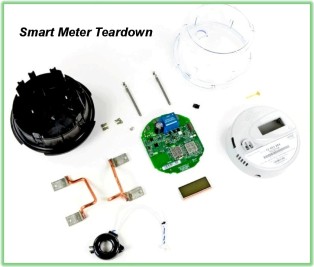 The first two problem areas discussed above are correctable through better installations and better quality controls. But the last area dealing with different construction materials, RF emissions, and use of electronic circuit boards is more problematic and indicative of an inherent design problem. One can also make the somewhat subjective observation that the analog meter typically has an industrial look to it, but a smart meter looks to be more of a “consumer electronics” quality. Refer to the figures for views of both types of meters during a “teardown.” Most of the smart meter devices appear to be made of plastic with inclusion of a cheap looking circuit board. Is this circuit board suitable for use in harsh environments? Again, we need unbiased and independent evaluations for what seem to be common sense observations.
The first two problem areas discussed above are correctable through better installations and better quality controls. But the last area dealing with different construction materials, RF emissions, and use of electronic circuit boards is more problematic and indicative of an inherent design problem. One can also make the somewhat subjective observation that the analog meter typically has an industrial look to it, but a smart meter looks to be more of a “consumer electronics” quality. Refer to the figures for views of both types of meters during a “teardown.” Most of the smart meter devices appear to be made of plastic with inclusion of a cheap looking circuit board. Is this circuit board suitable for use in harsh environments? Again, we need unbiased and independent evaluations for what seem to be common sense observations.
Anecdotal evidence of “cheap” construction is apparent in the teardown of an Elster smart meter showing that large copper conductors inside the meter are spot welded to the lugs as shown in the photo image below. In this connection, there appears to be little surface area actually involved with the weld between the two conductors. This type of connection would limit proper current flow and could be a source of overheating of such a meter. The analogous connection looks more substantial in the partial teardown of an analog meter shown above.
Since traditional analog meters contain no electronics, they are not normally[*] subject to damage from utility line surges. All electronics require some degree of surge protection. The electronics inside smart meters typically employ metal-oxide varistors (MOVs) for overvoltage surge protection. The problem arises from the lack of the heavy heat sinking capacity of the MOVs. This is needed in order to avoid failure due to overheating when they are energized. The physical construction of the smart meters does not allow for the heat generated by the energized MOVs to escape into the environment as there are few metal parts to act as a heat sink. Under the right conditions of over-voltage and line impedance, it may be possible to cause the MOV to burst into flames. The Fire Marshal’s report from Toronto, Canada regarding local Canadian utility smart meters noted overheating and fires associated with MOVs. [Reference: Comments before the Maryland Public Service Commission, September 28, 2012]
[*] Excessive or repeated line surges may affect the accuracy of analog meters but are unlikely to be a fire hazard due to material construction and lack of electronics.
In another safety-related issue, it is known by utility companies that wireless RF emissions from smart meters can interfere with the function of ground fault circuit interrupters (GFCI) and arc fault circuit interrupters (AFCI). From a safety perspective these devices operate on selected circuits or outlets in the home to sense unbalanced currents to detect shock hazards or to detect changing patterns of current that may indicate an arc condition. Possibly without the knowledge of the homeowner, the function of these critical safety devices may be undermined by the installation of smart meters.
It is evident that utilities are struggling to deal with the fire issues. As reported in a 2013 Illinois Commerce Commission (ICC) report, some utilities are attempting to mitigate smart meter fire risks by “proactive temperature monitoring.” However, as stated in the ICC report:
“The majority of ComEd’s AMI meters are equipped with temperature sensors and can report their internal temperature on command … [a]though the temperature sensor was not designed for that function. … However, a problem with the scans soon made itself known. … Apparently, radiofrequencies can enter the meter and cause the temperature sensor to report significantly inaccurate measurements.”
Also, the previously mentioned document submitted to the Maryland Public Service Commission in the form of comments contains the following language:
“[T]he meter burned up despite the sensing device. Although no fire occurred, the safety system failed miserably. … [They] could actually hear the meter sizzling as if something was being fried inside it. … What this clearly demonstrates is that the remote sensing system the utilities are relying on is hardly foolproof. One can only imagine what would have happened if there had been a real fire.”
Underwriters Laboratories (UL) Certifications for Smart Meters Are Optional
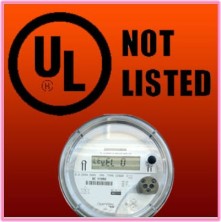 Another fact worth mentioning is that smart meters are generally not certified by Underwriters Laboratories (UL). This demonstrates that smart meters have been deployed without proper consideration for the safety of the homeowner. Underwriters Laboratories has a program for listing of utility meters, but it is voluntary in nature for meter manufacturers since there is no regulation that requires UL certification. Alternatively, a utility company could require UL certification for any purchased smart meters as part of a project specification. [Commentary: Imagine that, all the mandates on the consumer, but there is no mandate for the utility to install a UL certified meter on your home.]
Another fact worth mentioning is that smart meters are generally not certified by Underwriters Laboratories (UL). This demonstrates that smart meters have been deployed without proper consideration for the safety of the homeowner. Underwriters Laboratories has a program for listing of utility meters, but it is voluntary in nature for meter manufacturers since there is no regulation that requires UL certification. Alternatively, a utility company could require UL certification for any purchased smart meters as part of a project specification. [Commentary: Imagine that, all the mandates on the consumer, but there is no mandate for the utility to install a UL certified meter on your home.]
In 2013, Underwriters Laboratories published a standard entitled, “UL 2735, Standard for Safety for Electric Utility Meters.” In a document prepared by UL describing the new standard, words are used that are quite telling in terms of revealing the inherent risks and problems associated with smart meters as compared with traditional meters:
“The introduction of smart meters raises new concerns about functional safety, performance and product safety, data security, and interoperability, which are not fully addressed by the [current] standards. …
This [new] standard was developed to address problems that have been reported from field installations of smart meters, including fires, meters ejecting from meter socket bases and exposed live parts. When electronic components are overstressed, there is a potential for the components to explode. Among other things, UL 2735 addresses the potential flammability of plastic enclosure materials under fault conditions. … For meters utilizing batteries, the batteries are evaluated to determine that they will not cause an explosion or produce a risk of fire as a result of either excessive charge or discharge, or if a battery is installed with incorrect polarity.”
So if we are lucky, the new UL standard may help mitigate fire and explosion problems related to smart meters. However, there are currently no requirements forcing utilities to use UL certified smart meters in the future or to go back and test/replace currently deployed smart meters to this new standard even if it does somehow lessen the risks. The above quoted UL document lends considerable credence to the assertion that there are increased fire and safety-related risks associated with smart meters as compared to traditional analog meters.
No More Inspections by Meter Readers
A review conducted by the Illinois Commerce Commission (ICC) found a number of problems associated with the Commonwealth Edison smart meter program that could contribute to fire-related situations. One of the concerns identified in the ICC report is as follows:
“When and where Illinois utilities have completed their smart meter installation programs, they will have no further need for meter readers. With the loss of meter readers, monthly utility visits to meters and meter bases will also end. Meter readers have always provided at least a visual, if superficial, monthly inspection of the exterior of meters and meter bases. Meter readers are not meter experts or meter technicians, but they may identify unsafe conditions visible from the outside of the meter base, such as obvious signs of an accident and any overheating serious enough to cause discoloring of the outside of the equipment. … The future absence of meter readers … reduce[s] the number of opportunities for utility employees to observe signs of and evaluate the potential for future meter base overheating.”
The concern expressed by the ICC is consistent with that of the National Electrical Manufacturers Association (NEMA) where it stated that:
“As utilities move to two-way communications for meters and remote meter reading, the opportunity for periodic and repetitive visual inspection of meter sockets is expected to decline radically. The interval between site visits by utility personnel could be as much as 100 times as long as the current monthly opportunity for inspection.”
Concerns Over Transparency and Willingness to Acknowledge Problems
Although the Saskatchewan government is to be commended for finally taking action to protect the public, there are many instances where other government agencies, utilities, and the smart grid industry throughout the world are reluctant to acknowledge increased fire-related risks associated with smart meters. This can be demonstrated by watching the video shown below where the official company position doesn’t match the “facts on the ground” (literally).
[The above video contains material used pursuant to Fair Use Doctrine under 17 U.S.C. 107 and is presented in the public’s interest for non-commercial purposes.]
Another issue is whether fire investigations by local fire departments actually determine the true cause of “electrical fires” that are initially reported as such in the media and where no final word is ever disclosed as to whether the fire may have been caused by a smart meter. In many cases, a fire investigation is basically done to rule out arson, and the average investigator is not trained or qualified to determine conclusive origin and cause of electrical fires.
Conclusions
From the available evidence, albeit some of it is anecdotal in nature, smart meters for a number of reasons increase the risk of fire to homeowners as compared to analog utility meters. It is also important to emphasize that the concerns do not just relate to one model of smart meter being worse than another. All smart meters would appear to have inherent increased fire and safety-related risks as compared to traditional analog meters. Some smart grid advocates may claim that “small” increases in fire risk are acceptable because they still believe in the mythical benefits to one day be delivered through the smart meter. The problem is that for any risk analysis that results in potentially catastrophic consequences for one alternative versus another, any increased risk is generally considered unacceptable. Case in point, … Saskatchewan, Canada. … Do you still want a smart meter on your home? I didn’t think so.
Other Relevant Videos
**
[The above video contains material used pursuant to Fair Use Doctrine under 17 U.S.C. 107 and is presented in the public’s interest for non-commercial purposes.]
[The above video contains material used pursuant to Fair Use Doctrine under 17 U.S.C. 107 and is presented in the public’s interest for non-commercial purposes.]

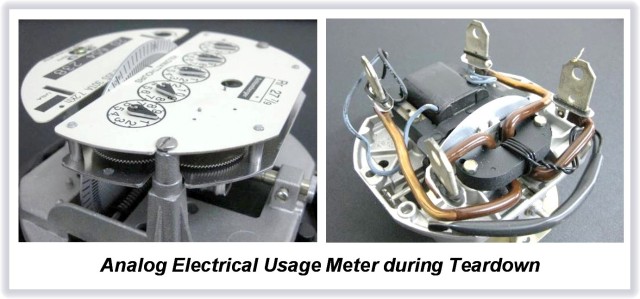
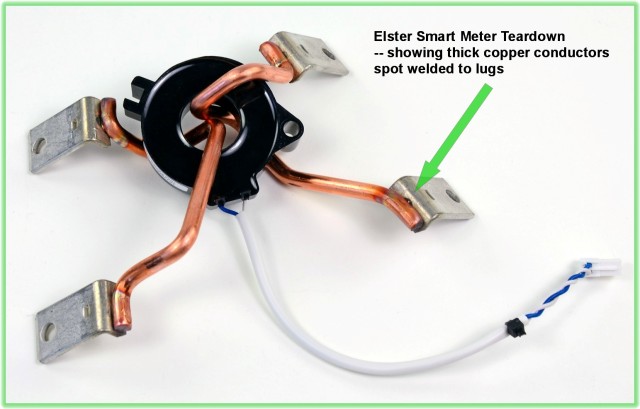

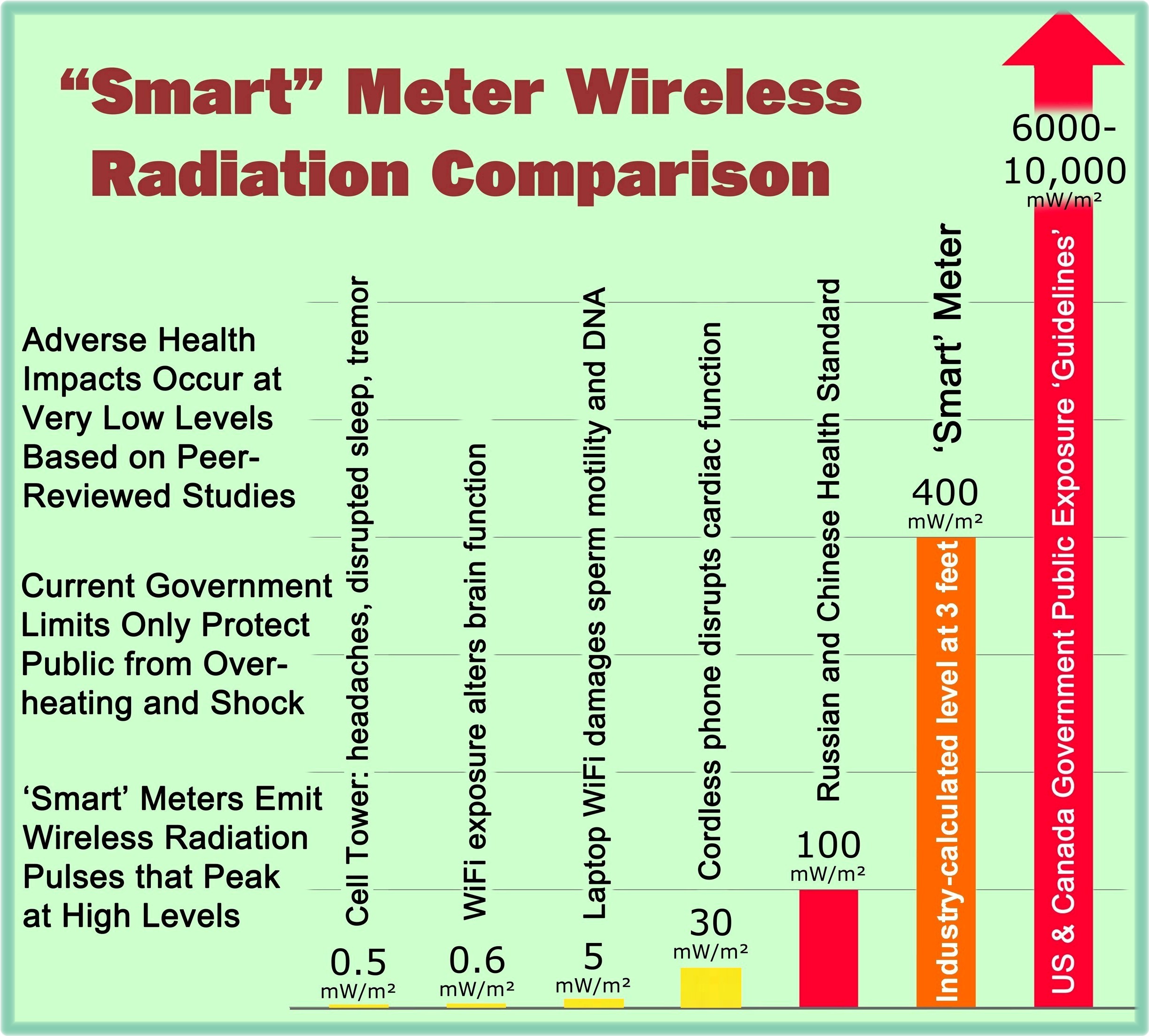


Thanks Fritz, you’re right on the money!
Basically an excellent blog piece overall, but there is one point that I would like to clarify with regards to the metal oxide varistor surge protectors. Metal oxide varistor surge protectors protect circuitry by shunting excess voltages to ground, so if there is a power surge, lightening strike, voltage spike, it will bleed it off. So lets say that the rating for the MOV is 120 volts AC, so anything over that exceeds what is known as the breakdown voltage where the MOV starts to conduct, you can sort of think of it as like an overflow on you bathtub, once the water gets past a certain level it drains off, but the MOV does this instantly. However each time this happens the materials inside of the MOV are damaged slightly, so instead of simply bleeding that excess voltage to ground the MOV becomes a little more resistive, resistance produces heat.
Over time, a number of years lets say, the MOV is compromised enough that it becomes hotter and hotter each time it bleeds off excess voltage, at the same time the breakdown voltage drops to the point where it starts to conduct at a lower and lower voltage until it is conducting all the time, and eventually forms a short circuit. This was what was happening with surge protected computer power bars a few years ago, after so many years, and so many surges bled off, the MOV would start to conduct all the time, heat up, and light the plastic housing of the power bars on fire. A heat sink will not mitigate the potential fire hazard of these, what will is to connect a thermal fuse in series, or to discard them in favor of an alternative method such as avalanche diodes or a gas discharge tube. The reason MOVs were chosen is that they are the cheapest form of surge protectors available on the market, you can buy some versions for as little as $.10 a piece. It is recommended that these sorts of power bars be discarded and replaced after five years of service.
So getting back to what was mentioned in the piece about the electronics in a not-so smart meter appearing to resemble cheap, consumer grade, electronics, they resemble consumer grade electronics because they are consumer grade electronics. So rather then choosing something safe, reliable, like avalanche diode surge protection they went the cheap route, in some cases they mount the MOV right on the circuit board. Another indication that not so smart meters employ cheap consumer grade electronics is in the use of surface mount components, there are two places where surface mount components have no business being used, in a power supply and in a rough service environment which is where the majority of electric power meters are going to be installed.
Two other points of failure are the rechargeable batteries and any electrolytic capacitors they may use, the batteries could cause a fire if they are of the lithium polymer type, the electrolytics will not although they can short out. If they used a good brand of capacitor, maybe they will hold up, if they used a cheap brand then all bets are off, electrolytic capacitors hate heat and over voltages. In fact electronics of all sort hate three things, moisture, heat, and temperature changes.